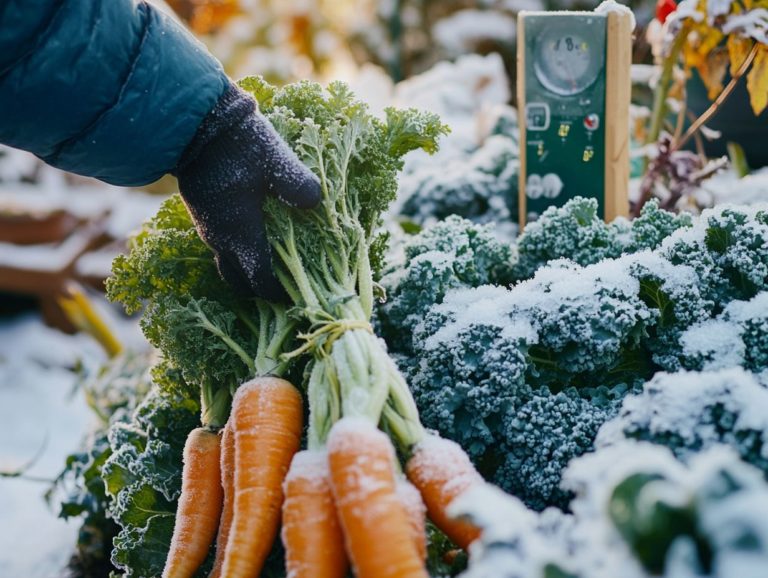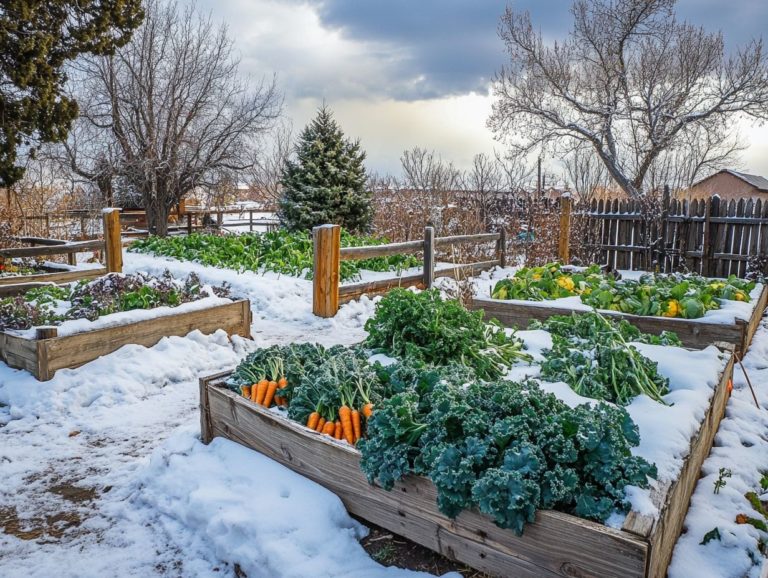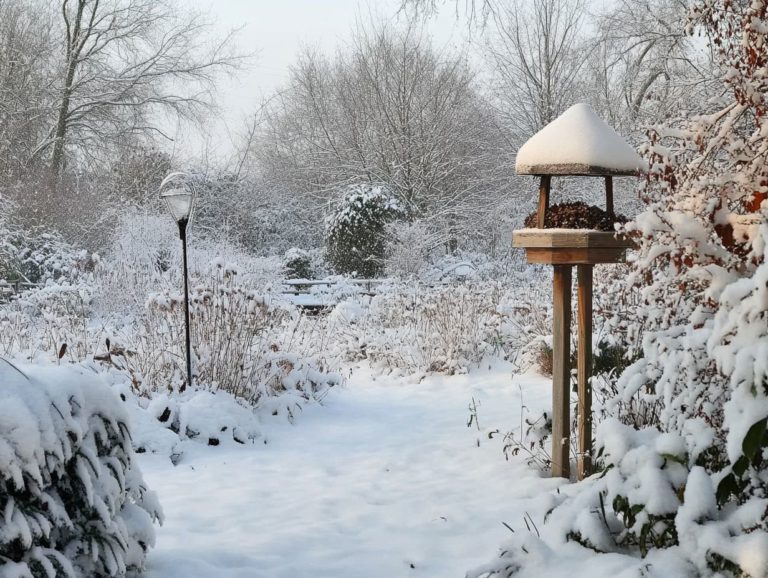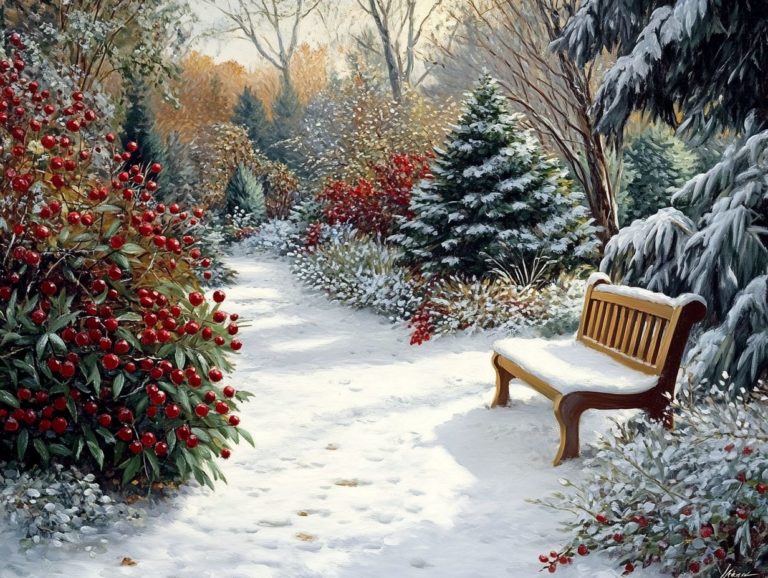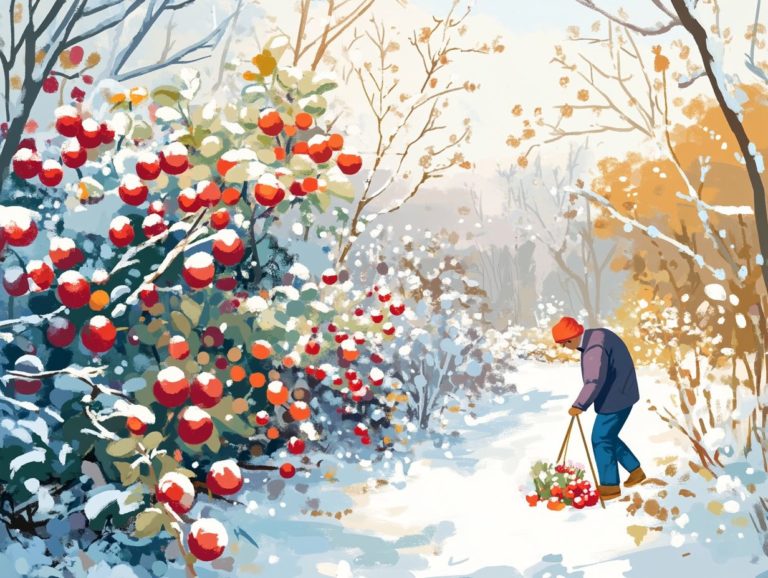How to Start Seeds Indoors for Cold Climates?
Starting seeds indoors transforms your gardening experience, especially in colder climates. It allows you to take charge of your planting schedule while significantly increasing the success rate of your seedlings.
This article explores the many benefits of starting your gardening journey indoors, from selecting the ideal seeds to creating the perfect environment for optimal growth.
You ll also discover essential materials, effective care techniques, and valuable tips for transitioning your flourishing seedlings outdoors.
Get ready to grow a stunning garden that bursts with life!
Contents
- Key Takeaways:
- Benefits of Starting Seeds Indoors
- Find Your Perfect Seeds for Indoor Success!
- Materials and Equipment Needed
- Preparing Seeds for Planting
- Creating the Ideal Environment
- Caring for Seedlings
- Transferring Seedlings Outdoors
- Frequently Asked Questions
- What materials do I need to start seeds indoors for cold climates?
- When should I start my seeds indoors for cold climates?
- Do I need any special equipment to start seeds indoors for cold climates?
- How do I prepare the seed starting mix for cold climate seeds?
- How often should I water my seeds when starting them indoors for cold climates?
- Can I start any type of seeds indoors for cold climates?
Key Takeaways:
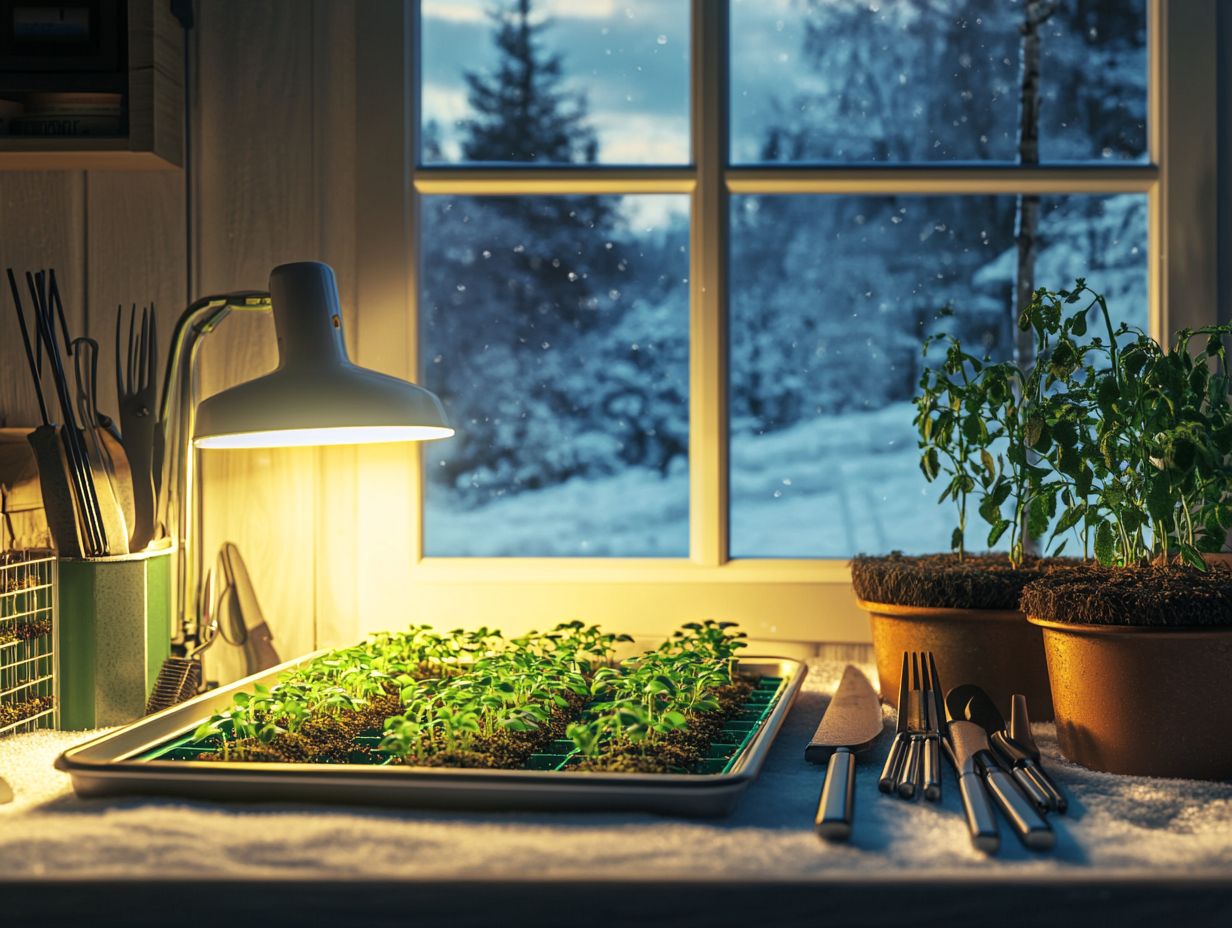
- Starting seeds indoors helps you grow plants better, saves money, and gives you more control.
- When choosing seeds, consider cold tolerance, germination time, and plant size.
- Provide proper light, temperature, and humidity for your seeds to thrive, and water gently when the time is right.
Benefits of Starting Seeds Indoors
Starting seeds indoors offers a wealth of advantages that can elevate your gardening experience, especially in regions with shorter growing seasons. By germinating seeds in a controlled environment, like a cold frame or mini-greenhouses, you can fine-tune the growing conditions for your seedlings. For those in colder areas, it’s also important to know when to start planting to maximize your garden’s potential.
This method boosts germination rates with high-quality seeds and allows for superior moisture management, helping to prevent common seedling problems where they become weak and die. For those interested in optimizing their efforts, seed starting for winter: a guide can be invaluable. Indoor gardening also lets you time your transplanting perfectly, ensuring your plants are ready for the great outdoors as soon as the season allows.
Why Start Seeds Indoors?
Starting seeds indoors lets you enjoy a longer growing season while controlling essential environmental factors crucial for seed germination. For those interested in maximizing their efforts, knowing the best sources for cold-climate seeds can be very beneficial.
By creating a nurturing environment with optimal light, temperature, and moisture levels, you can give your plants the best possible start. Seed packets are particularly helpful, as they come with specific instructions for each plant type, ensuring the ideal conditions for growth.
Paying close attention to transplanting dates is vital. It maximizes your seedlings’ chances of thriving outdoors, leading to healthier, more robust plants. This practice enhances your success rates and allows for staggered plantings of varieties such as Genovese basil, tomatoes, and peppers, providing continuous harvests throughout the season.
Find Your Perfect Seeds for Indoor Success!
Selecting the right seeds is essential for a successful indoor gardening experience, particularly when you focus on high-quality seeds that thrive in your specific growing environment.
Consider varieties like Genovese basil, tomatoes, peppers, eggplants, and a selection of cruciferous vegetables such as broccoli, cauliflower, cabbage, lettuce, and kale. These are excellent choices for starting seeds indoors.
By choosing the appropriate seeds, especially those from the Solanaceae family, you enhance growth and yield while creating optimal conditions that meet the plants’ unique needs, increasing their resilience against common challenges.
Factors to Consider
When selecting seeds for your indoor garden, several key factors require your attention, including the type of plant (like broccoli and cauliflower), seed quality, and your anticipated transplanting date.
Understanding these elements is crucial for a successful gardening experience. Seed quality, which includes germination rates and freshness, can significantly influence your growth outcomes. Check packaging for production dates or choose reputable suppliers to ensure the viability of your seeds.
Consider how well the plants will thrive in your indoor conditions; factors like light, humidity, and temperature will guide you toward varieties that flourish in limited spaces. Growth habits are equally important; knowing whether a plant tends to be bushy or vining will help you plan for adequate room and support.
Evaluating space requirements not only helps you arrange your plants optimally but also prevents overcrowding, which could stifle growth and diminish your gardening success.
Materials and Equipment Needed
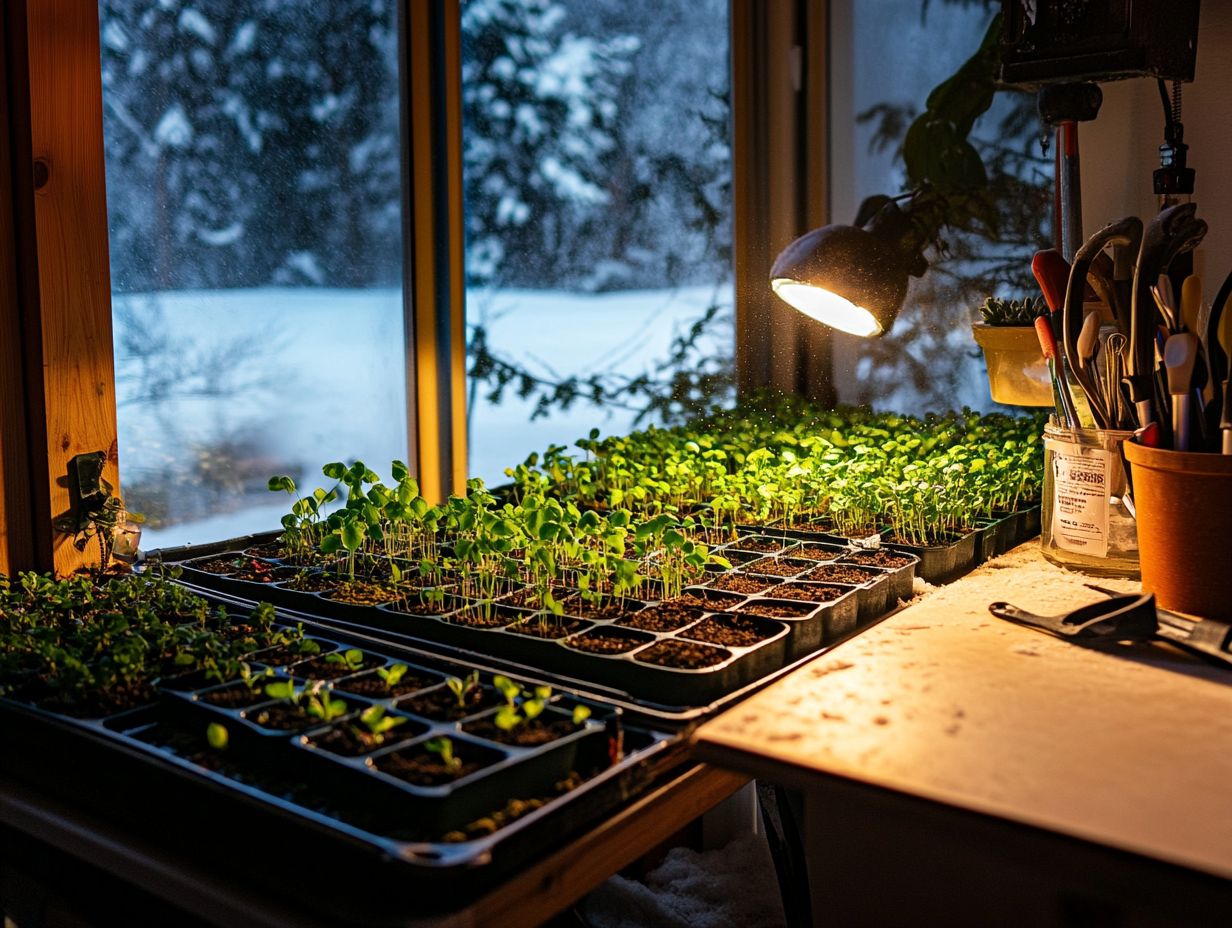
To successfully start seeds indoors, gather the right materials and equipment to create optimal conditions for germination and growth. Key items include a high-quality seed starting mix that provides essential nutrients and drainage for your seedlings, as well as understanding the importance of preparing your soil for spring in cold climates.
Also, consider light seed-starting systems that mimic natural sunlight. Heat mats can elevate soil temperatures, promoting faster germination. Meanwhile, mini-greenhouses help maintain humidity, creating a controlled environment perfect for nurturing young plants. A trip to your local garden center can help you discover the best supplies tailored to your growing needs.
Essential Tools for Indoor Seed Starting
Essential tools for indoor seed starting include a premium seed starting mix, effective light setups, heat mats, and mini-greenhouses that create the perfect environment for your seedlings.
These tools are game-changers for your gardening success! They establish optimal conditions for seed germination and early plant growth. For example, a high-quality seed starting mix provides the right balance of drainage and aeration for young roots, preventing a common seedling problem.
Light setups, including full-spectrum LED grow lights, mimic natural sunlight, ensuring your seedlings receive adequate light for photosynthesis and thrive in a south-facing window. Heat mats deliver consistent warmth, essential for germination, especially for those heat-loving plants that thrive in cozy conditions.
Mini-greenhouses whether you purchase one or create a DIY version help maintain humidity and temperature, both crucial for nurturing your tender new plants. You can find most of these tools at local garden centers or online retailers, with various options to fit different budgets and gardening styles.
Whether you re just starting out with winter sowing or have a wealth of experience, using these essential items can significantly enhance your indoor gardening success. Head to your local garden center today and get started on your indoor gardening adventure!
Preparing Seeds for Planting
Preparing seeds for planting is an essential step in your indoor gardening journey. It sets the stage for optimal germination and growth. Start by selecting the right seed packets and soaking them if needed, ensuring that the moisture levels in your seed starting mix are just right.
Make sure your planting schedule matches when you want to transplant. By following these preparation steps, you boost the chances of cultivating robust seedlings like sage and rosemary, enjoying a rich growing experience.
Steps for Preparing Seeds for Indoor Planting
Preparing seeds for indoor planting requires a meticulous approach that involves handling seed packets, assessing moisture levels, and creating optimal conditions for germination.
- Start by inspecting each seed packet for specific instructions and expiration dates, as these can influence germination rates.
- When ready to plant, gently remove the seeds from their packets, ensuring no damage occurs.
- Next, check moisture levels; your seeds should feel slightly moist but definitely not soggy.
- A humidity dome is a fantastic tool to help maintain the ideal environment while shielding against potential fungal issues.
- Utilizing sterile soil and spacing your seeds appropriately encourages healthier growth and minimizes competition for nutrients.
- Regularly check moisture levels, adjusting as needed to nurture strong, thriving seedlings.
Creating the Ideal Environment
Creating the perfect environment for seed starting is essential for your success in indoor gardening. It involves a delicate balance of light, temperature, and humidity to cater to the needs of your seedlings.
Use effective light setups to boost your seedlings! By employing effective light seed-starting setups, such as those available at your local garden center, you ensure that your germinating seeds receive the illumination they require. Temperature control is equally crucial; it safeguards your seedlings from stress during those vital early growth stages.
Maintaining optimal humidity levels is also important. It ensures moisture retention in the seed starting mix, which is key for fostering healthy roots and vigorous growth. By thoughtfully managing these elements, you set the stage for flourishing plants.
Light, Temperature, and Humidity Requirements

Light, temperature, and humidity are essential elements for achieving successful seed germination and growth in your indoor gardening journey.
To cultivate an optimal environment for your seeds, consider specific light conditions. Ideally, provide them with 12 to 16 hours of bright, indirect light each day. Different seeds thrive under various temperature ranges. Warm-season crops like tomatoes prefer a cozy 70-80 F, while cool-season varieties such as lettuce flourish in the cooler 60-70 F range.
Maintaining the right humidity levels is crucial; many seeds thrive at a relative humidity of 40-60%, allowing them to retain moisture without the risk of mold. Using a humidity dome a clear cover that maintains moisture can help you regulate moisture effectively. Additionally, grow lights will simulate natural sunlight, ensuring a vibrant and healthy indoor garden.
Caring for Seedlings
Caring for seedlings requires a keen understanding of their unique needs. This includes mastering the art of proper watering, selecting the right fertilizers, and knowing when to transplant.
By paying attention to these details, you can foster their healthy growth and development, ensuring they thrive.
Watering Tips
Watering is vital to the care of your seedlings, directly impacting their growth and readiness for outdoor life. Aim for consistent moisture while avoiding waterlogging, as that can lead to root rot.
Fertilizing Tips
Fertilization requires a delicate touch. Using a diluted organic fertilizer can deliver essential nutrients without overwhelming those tender seedlings.
Transplanting Tips
Timing is crucial for transplanting. Wait until your seedlings have established sturdy roots and are acclimated to outdoor temperatures. Gradually introduce them to full sun and outdoor conditions to help minimize transplant shock.
Transferring Seedlings Outdoors
Transferring seedlings outdoors marks a key moment in your gardening journey, demanding careful planning when selecting the ideal transplanting date. This careful timing is essential for ensuring a seamless transition from the nurturing environment of indoor growth to the expansive embrace of your garden.
Get ready to watch your garden flourish make your plans today!
When and How to Move Seedlings into the Garden
Understanding when and how to move your seedlings into the garden is crucial for their success. It s all about finding the best time to move your seedlings, considering your local climate conditions and the specific needs of your plants.
Seasonal temperature fluctuations, soil type, and the overall weather patterns in your region all play a significant role in this process. Keeping an eye on your local frost dates is essential. This helps you decide the right moment to transition your seedlings from the comforts of indoor life to the great outdoors.
You ll also want to consider factors like sunlight exposure, humidity levels, and the soil s moisture content before making the big move. Get excited! Preparing your seedlings is the key to their success. Gradually introducing seedlings to outdoor conditions, known as hardening off, will acclimate them to their new environment.
Following these steps can lead to robust, thriving plants that adapt beautifully to their surroundings. Get ready to watch your garden thrive!
Frequently Asked Questions
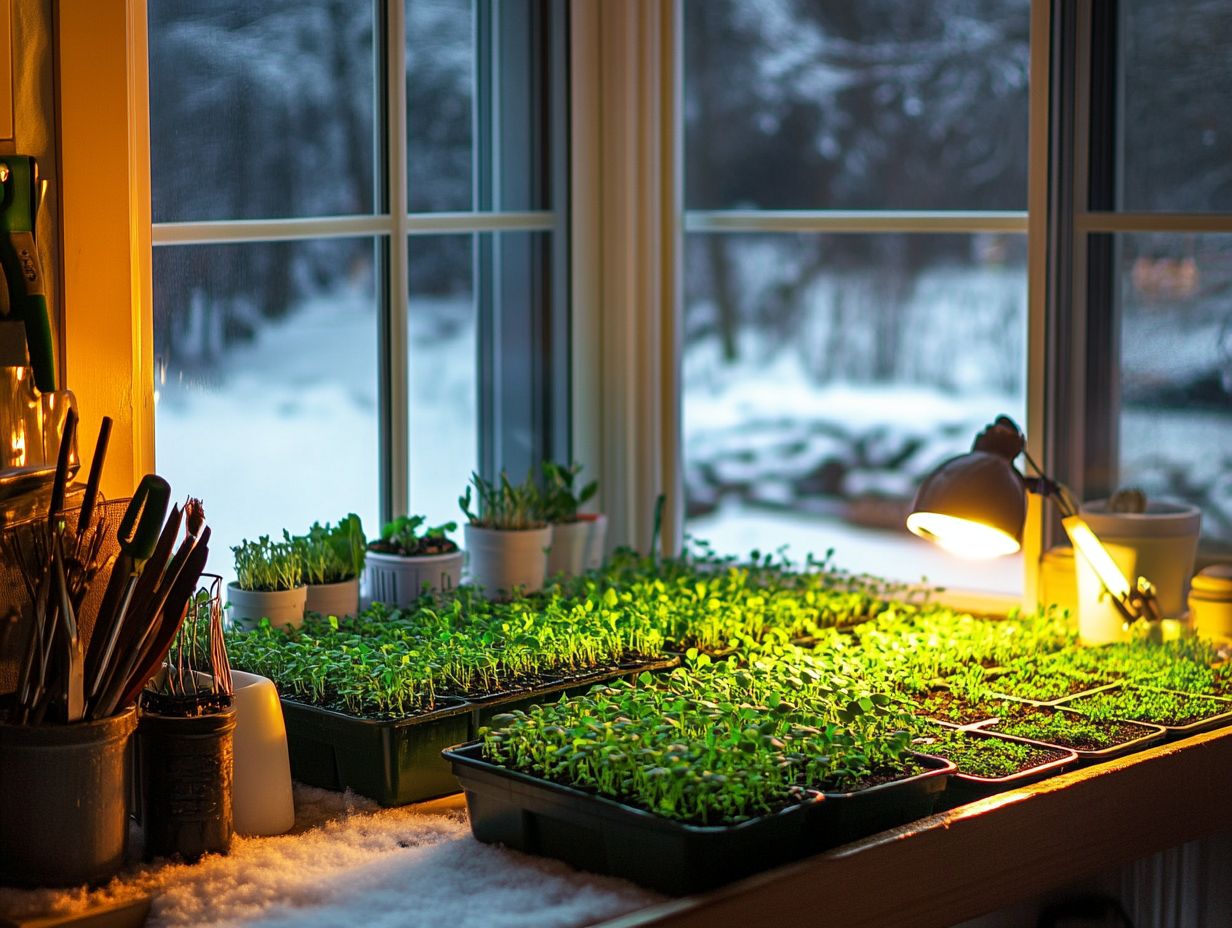
What materials do I need to start seeds indoors for cold climates?
To start seeds indoors for cold climates, you will need seeds, seed starting mix, containers or trays, a watering can, and a light source. For more detailed guidance, check out this resource on how to start a cold-climate garden.
When should I start my seeds indoors for cold climates?
The timing for starting seeds indoors for cold climates depends on the specific plants you are growing. Generally, you should start your seeds 4-6 weeks before the last frost date in your area, and using the right tools can make a difference. Consider checking out the top 7 seed starting kits for cold climates for optimal results.
Do I need any special equipment to start seeds indoors for cold climates?
No, you do not need any special equipment. However, a heat mat or grow lights can be helpful in providing the optimal conditions for seed germination.
How do I prepare the seed starting mix for cold climate seeds?
Start by moistening the seed starting mix with warm water. Then, fill your containers or trays with the mix, leaving a small space at the top for watering.
How often should I water my seeds when starting them indoors for cold climates?
You should water your seeds as needed to keep the soil moist, but not soggy. Check the soil regularly and water when the top feels dry.
Can I start any type of seeds indoors for cold climates?
While many plants can be started indoors for cold climates, some may not thrive in a controlled indoor environment. To maximize your success, it’s best to research how to use greenhouses for cold-climate gardening and understand the specific needs of the plants you want to grow before starting them indoors.

